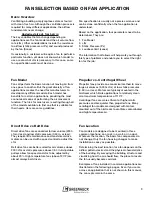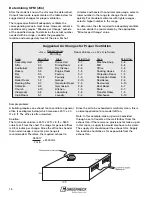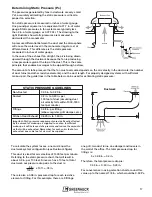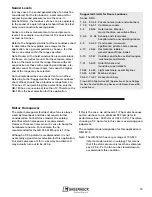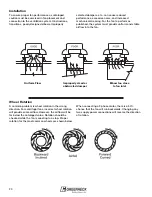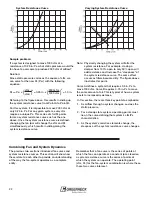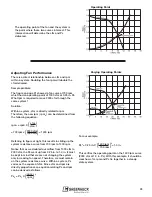
Combining Fan and System Dynamics
The previous two sections introduced fan curves and
system resistance curves. This section will show how
these relate to each other to provide an understanding
of the way the fan-system operates as a complete
entity.
Remember that a fan curve is the series of points at
which the fan can operate at a constant rpm. Likewise,
a system resistance curve is the series of points at
which the system can operate. The operating point
(cfm, Ps) for the fan-system combination is where these
these two curves intersect.
Sample problem:
If a system is designed to move 1000 cfm at a
resistance of 0.25 in. Ps, what static pressure would the
fan have to overcome to produce 2000 cfm of airflow?
Solution:
Since static pressure varies as the square of cfm, we
can solve for the new Ps (Ps
2
) with the following
equation:
Ps
2
= Ps
1
x
(
cfm
2
)
2
= 0.25 in. x
(
2000 c f m
)
2
= 1.0 in.
cfm
1
1000 cfm
Referring to the figure above, this results in sliding up
the system resistance curve from Point A to Point B.
For this system, it is impossible to move 2000 cfm at
only 0.25 in. Ps. For any given system, every cfm
requires a unique Ps. This series of cfm/Ps points
forms a system resistance curve such as the one
above. Once the system resistance curve is defined,
changing the fan rpm will change the cfm and Ps
simultaneously, which results in sliding along the
system resistance curve.
Note: Physically changing the system will alter the
system resistance. For example, closing a
damper from 100% open to only 50% open will
add resistance and increase the “steepness” of
the system resistance curve. The same effect
occurs as filters become dirty. The figure above
illustrates this point.
Curve A defines a system that requires 0.5 in. Ps to
move 1000 cfm. Curve B requires 0.75 in. Ps to move
the same amount of air. This is typical of how a system
reacts to increased resistance.
In this section, there are three key points to emphasize:
1. As airflow through a system changes, so does the
static pressure.
2. For a steady-state system, operating points must
lie on the curve defining that system’s cfm/Ps
characteristics.
3. As the system’s resistive elements change, the
steepness of the system resistance curve changes.
22
System Resistance Curve
Varying System Resistance Curve


